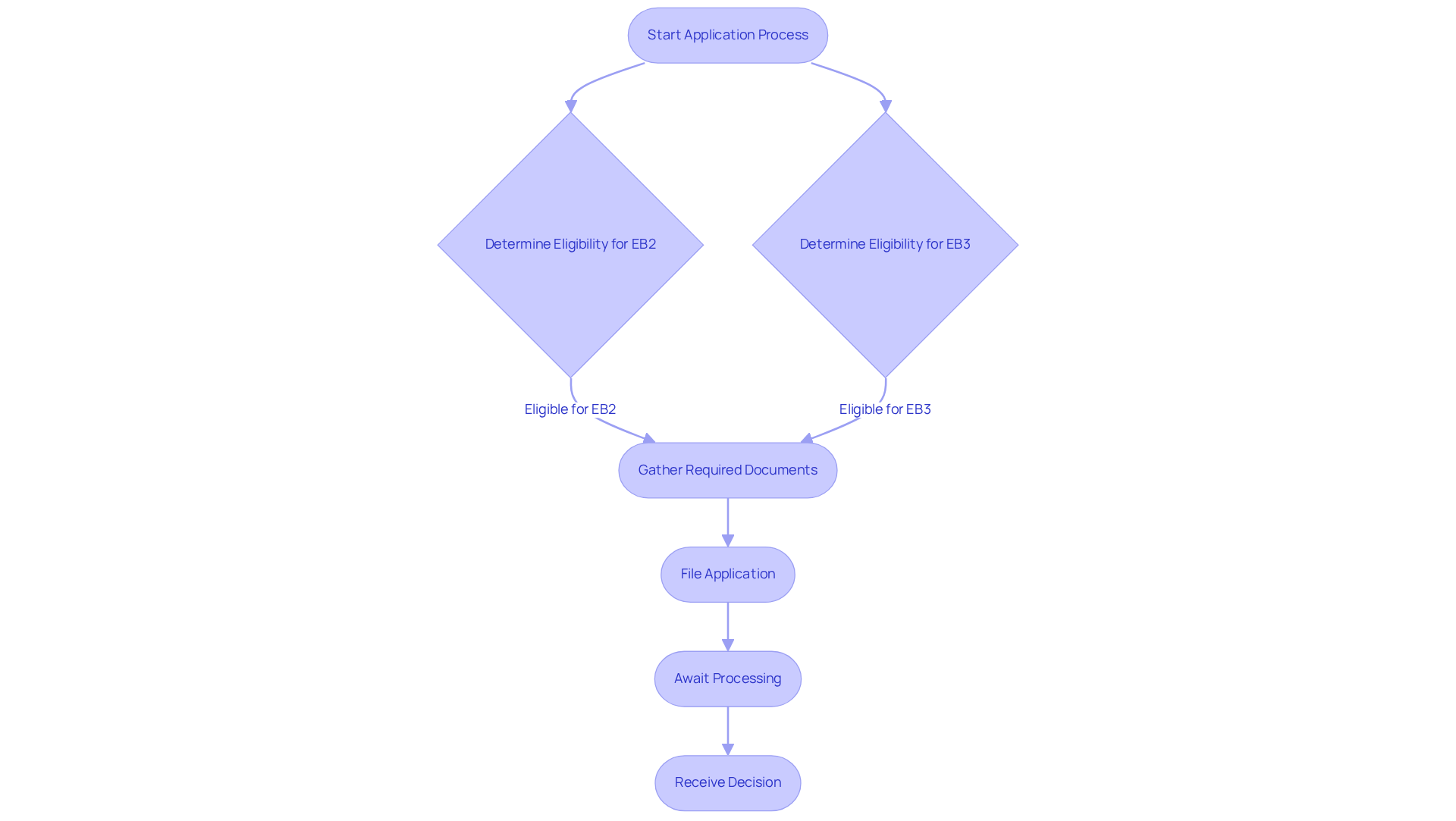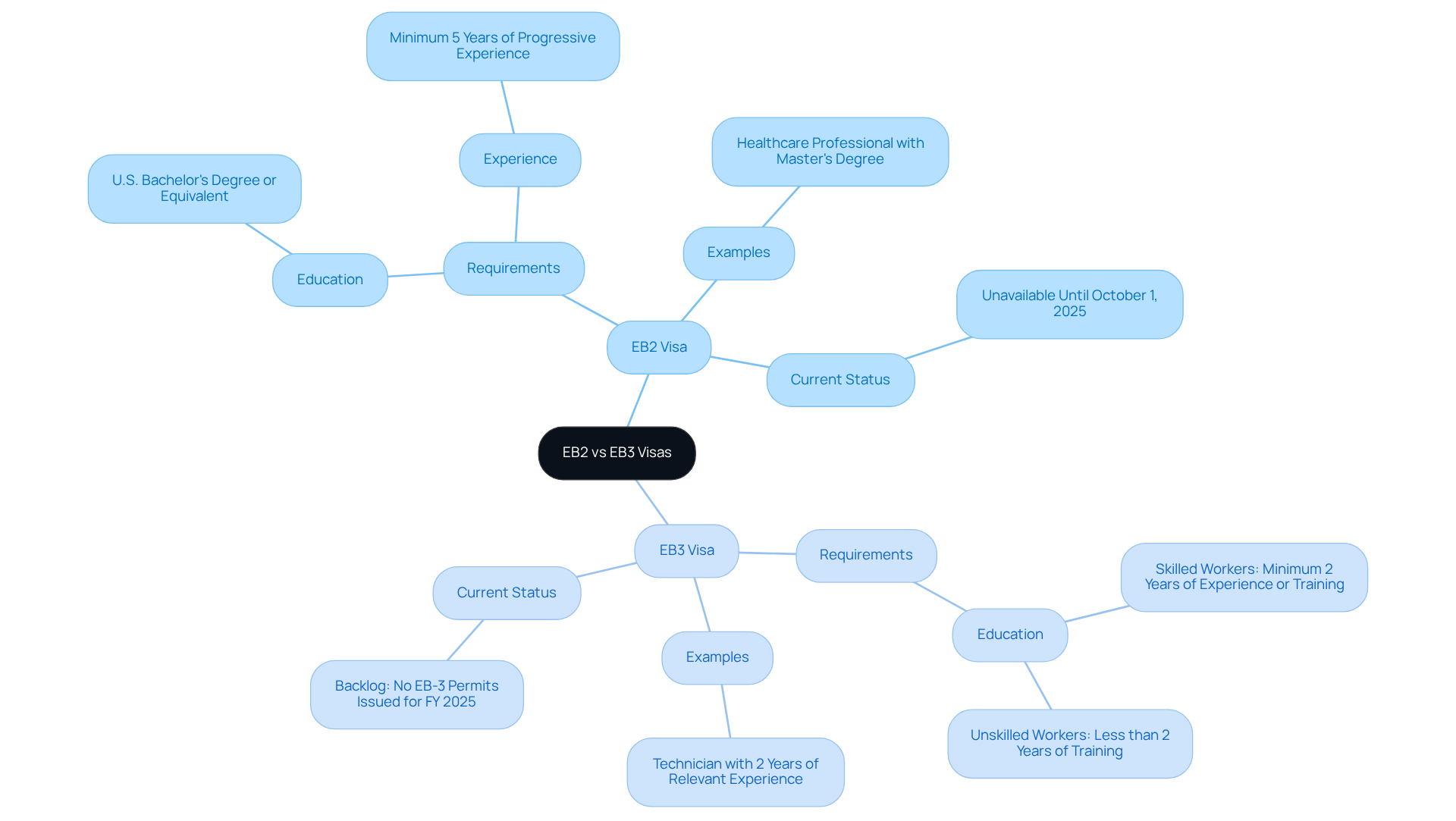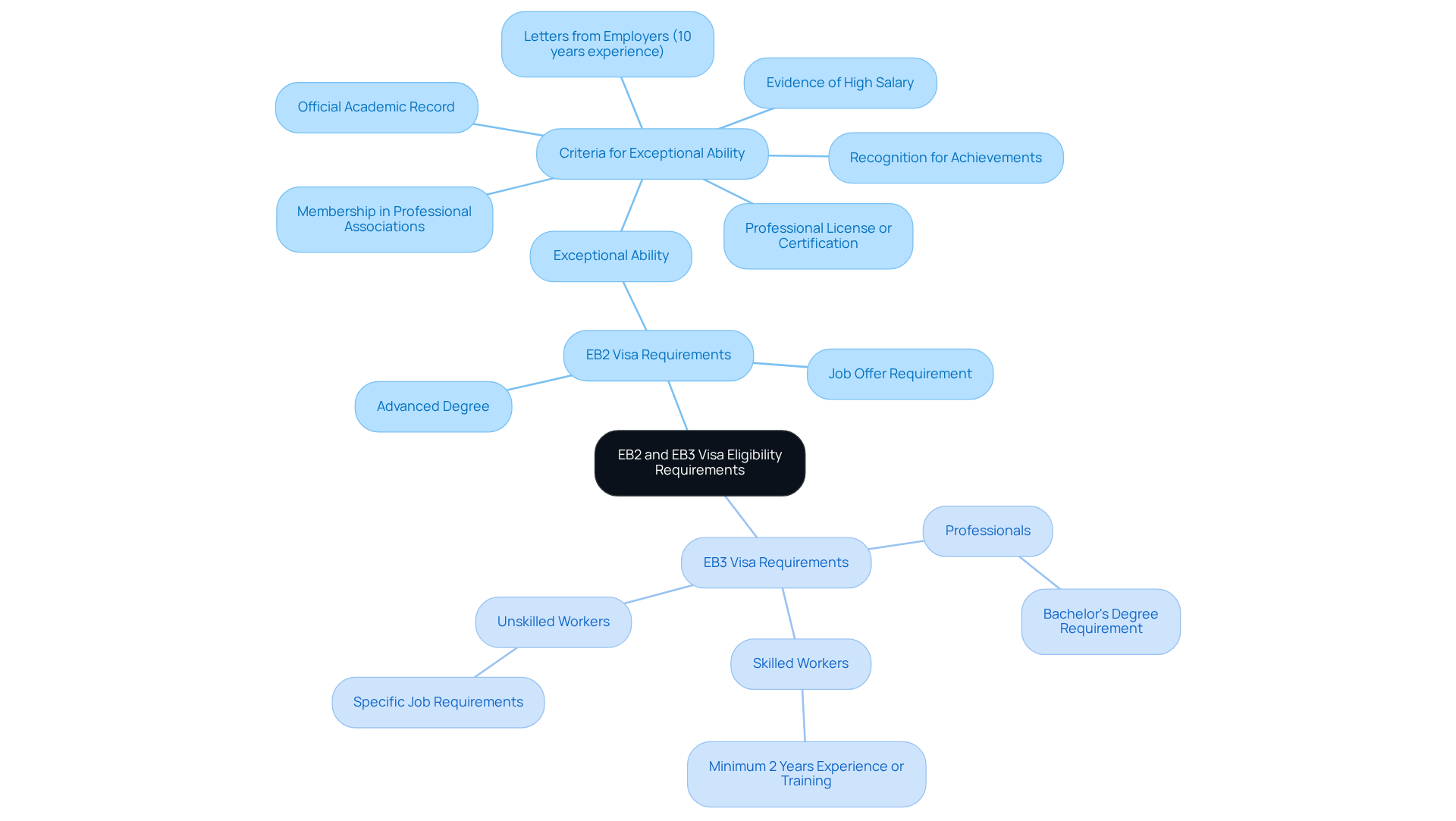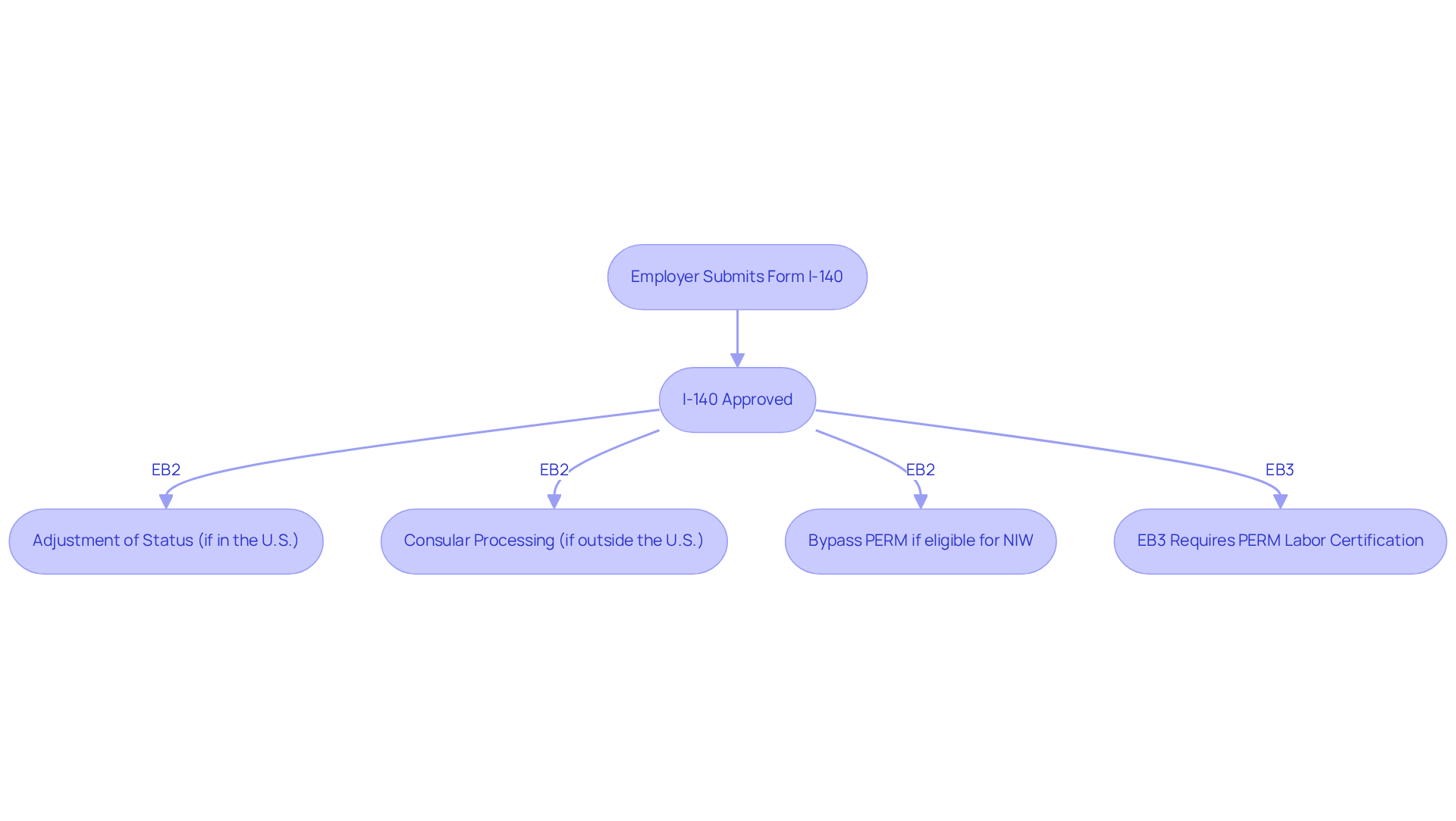Overview
Understanding the differences between EB2 and EB3 visas is crucial for anyone navigating the complex immigration landscape. EB2 is designed for individuals with advanced degrees or exceptional abilities, while EB3 accommodates skilled workers, professionals, and unskilled laborers.
Have you ever felt overwhelmed by these distinctions? It’s essential to grasp how these categories can significantly impact your immigration options, especially in light of current approval limitations.
Remember, you’re not alone in this fight; we’re here to support you every step of the way.
Introduction
Navigating the complexities of employment-based immigration can feel overwhelming, especially with the recent changes affecting EB2 and EB3 visa applications. Have you ever felt lost in this confusing process? Understanding the key differences between these two categories is crucial for those looking to secure their future in the United States.
As annual quotas shift and the landscape evolves, how can you ensure you choose the right path for your unique qualifications? This article delves into the essential differences and eligibility requirements for EB2 and EB3 visas, providing vital insights to empower you in making informed decisions during this challenging immigration journey.
Remember, you’re not alone in this fight—we’re here to support you every step of the way.
Vasquez Law Firm: Expert Guidance on EB2 and EB3 Visa Applications
Vasquez Law Firm is here to fight for you, specializing in the complexities of EB2 vs EB3 applications, drawing on over 30 years of experience in immigration law. Have you ever felt lost in the immigration process? We understand how overwhelming this feels, especially with the recent changes for 2025, including the suspension of EB2 approvals until October 1, 2025, which has led to discussions about EB2 vs EB3 due to the annual quota being reached. Our expertise is crucial as you navigate your options in this evolving landscape.
Our bilingual team ensures Spanish-speaking clients receive clear and accessible communication throughout the application process. This commitment to personalized legal strategies has led to a remarkable success rate, empowering thousands of clients to achieve their immigration goals. For instance, many candidates whose priority dates became current between April and September 2025 successfully relocated to the U.S. as permanent residents. This showcases the effectiveness of timely filings—because you don’t have to face this alone.
With an emphasis on offering customized solutions, Vasquez Law Firm continues to be a reliable ally for individuals maneuvering through the complexities of the EB2 vs EB3 processes. It’s important to know you have rights, even if others tell you otherwise. We’re in this fight with you, ensuring that you are well-informed and ready to seize opportunities as they emerge in the immigration system. Your future matters to us—let us help you take the next step.

Understanding the Core Differences Between EB2 and EB3 Visas
Navigating the world of employment-based immigration can feel overwhelming. The options of EB2 vs EB3 permits cater to different profiles. The EB2 visa targets individuals with advanced degrees or exceptional abilities, while the EB3 visa is broader, welcoming skilled workers, professionals, and even unskilled laborers. Understanding the distinctions in requirements between EB2 vs EB3 is crucial, as the educational and experience prerequisites differ significantly.
For instance, EB2 candidates typically need a U.S. bachelor's degree or its foreign equivalent, along with at least five years of progressive experience in their field. On the other hand, EB3 candidates must have a minimum of two years of job experience or training for skilled roles, while unskilled workers can qualify with less than two years of training. This knowledge is vital for anyone considering their immigration options.
Currently, there's a notable backlog in EB3 approvals, as this category has hit its annual limits for fiscal year 2025. This means no EB-3 permits will be issued for the rest of the fiscal year. It’s essential to grasp these nuances, as delays may arise based on the chosen category.
Consider real-life scenarios:
- A healthcare professional with a master's degree and specialized training may qualify for EB2.
- A technician with two years of relevant experience could apply under the EB2 vs EB3 classifications.
Specialists like Alison Moodie emphasize that understanding the distinctions of EB2 vs EB3 is crucial for candidates to align their qualifications with the appropriate immigration path, ultimately enhancing their chances for successful relocation. Remember, the yearly limits for the categories EB2 vs EB3 will reset on October 1, 2025, opening new doors for candidates.
We’re here to fight for your family and support you through this journey. Your future matters to us.

Eligibility Requirements for EB2 and EB3 Visas
Navigating the differences between EB2 vs EB3 categories can be daunting. To qualify, applicants need either an advanced degree—like a master’s or higher—or they must demonstrate exceptional ability in their field, which often includes healthcare, engineering, or academia. Currently, the EB2 category faces an annual cap of 28.6 percent of the global employment limit. Unfortunately, all EB2 permits for fiscal year 2025 have already been distributed. This means that embassies won’t issue additional EB2 permits until the new fiscal year begins on October 1, 2025.
In contrast, the EB2 vs EB3 categories each have their own specific requirements:
- Professionals must have at least a bachelor’s degree.
- Skilled workers need a minimum of two years of experience or training.
- Unskilled workers can also apply, but they must meet specific job requirements set by their employer.
Importantly, a permanent, full-time job offer from a U.S. employer is essential when considering EB2 vs EB3 categories.
Understanding these eligibility requirements is crucial for candidates looking to identify their best path forward, especially given the current restrictions on permit issuance. However, it’s worth noting that USCIS may still accept adjustment of status filings if an applicant’s EB2 priority date remains current under the Visa Bulletin, even if the annual cap has been reached. Additionally, both EB3 and EW permits have also hit their annual limits for fiscal year 2025, impacting overall availability.
You’re not alone in this process. We’re here to fight for your family and help you navigate these challenges.

Application Processes for EB2 and EB3 Visas Explained
Navigating the application procedure can feel overwhelming when considering EB2 vs EB3 categories. It typically starts with the employer submitting a Form I-140, Immigrant Petition for Alien Workers, to USCIS. If you’re considering the differences between EB2 vs EB3 categories, there’s a possibility to bypass the PERM labor certification if you qualify for a National Interest Waiver (NIW). However, the EB3 visa generally requires this certification, which means proving that there are no qualified U.S. workers available for the position when considering EB2 vs EB3.
Once your I-140 petition is approved, you can take the next step—either Adjustment of Status if you’re in the U.S. or Consular Processing if you’re outside the country. Understanding these processes is crucial; they can significantly impact your application experience. Remember, you’re not alone in this fight. We’re here to guide you every step of the way.

Conclusion
Understanding the differences between EB2 and EB3 visas is essential for anyone navigating the complexities of employment-based immigration. Each category presents unique eligibility requirements and application processes, making it crucial for applicants to align their qualifications with the appropriate visa type. With recent changes impacting approvals—particularly the suspension of EB2 approvals until October 2025 and the backlog in EB3 applications—being informed is more important than ever.
This article has outlined the key distinctions between EB2 and EB3 visas, highlighting their respective eligibility criteria, application processes, and the implications of the current immigration landscape. The EB2 visa caters to individuals with advanced degrees or exceptional abilities, while the EB3 visa encompasses a broader range of skilled and unskilled workers. Understanding these nuances can empower candidates to make informed decisions about their immigration paths and enhance their chances of success.
As the immigration environment continues to evolve, it’s vital to stay updated and seek expert guidance. The Vasquez Law Firm is committed to supporting individuals through this challenging journey, ensuring that applicants are well-informed and prepared to seize opportunities as they arise. Whether considering the EB2 vs EB3 options or navigating the application process, having reliable guidance can make all the difference in achieving immigration goals. Remember, you’re not alone in this fight—we’re here to fight for your family.
Frequently Asked Questions
What does Vasquez Law Firm specialize in?
Vasquez Law Firm specializes in EB2 and EB3 visa applications, leveraging over 30 years of experience in immigration law.
What recent changes have affected EB2 visa approvals?
There has been a suspension of EB2 approvals until October 1, 2025, due to the annual quota being reached.
How does Vasquez Law Firm assist clients in the immigration process?
The firm provides expert guidance, personalized legal strategies, and ensures clear communication, particularly for Spanish-speaking clients.
What has been the success rate of Vasquez Law Firm in helping clients with immigration?
The firm has a remarkable success rate, empowering thousands of clients to achieve their immigration goals, especially those whose priority dates became current between April and September 2025.
Why is timely filing important in the immigration process?
Timely filings are crucial as they can lead to successful relocation to the U.S. as permanent residents, especially in light of changing immigration policies.
What commitment does Vasquez Law Firm make to its clients?
The firm is committed to offering customized solutions and ensuring clients are well-informed about their rights and opportunities in the immigration system.
How does Vasquez Law Firm support its clients emotionally during the process?
The firm emphasizes that clients do not have to face the immigration process alone and positions itself as a reliable ally in navigating the complexities of EB2 and EB3 applications.




